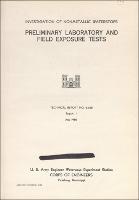Please use this identifier to cite or link to this item:
https://hdl.handle.net/11681/4719| Title: | Investigation of nonmetallic waterstops : report 1 : preliminary laboratory and field exposure tests |
| Authors: | U.S. Army Engineer Waterways Experiment Station |
| Keywords: | Sealing compounds Waterproofing Joints (Engineering) Polyvinyl chloride Rubber Plastics |
| Publisher: | U.S. Army Engineer Waterways Experiment Station. Engineer Research and Development Center (U.S.) |
| Series/Report no.: | Technical report (U.S. Army Engineer Waterways Experiment Station) ; 6-546 rept.1. |
| Description: | Technical Report Summary: Requirements for rubber waterstops are given in Corps of Engineers Guide Specifications CE 1402; however, these specifications did not give requirements for waterstops made from plastics, which have recently been introduced and proposed for use in Corps of Engineers construction. This investigation was intended to provide information on the comparative performance of various types of nonmetallic waterstops. The investigation is not yet complete in that additional tests are contemplated and weathering tests are still in progress, future results will be reported as they are obtained. In the part of the investigation reported herein, laboratory tests were performed on nonmetallic waterstop materials (several types of rubber, polyethylene, and polyvinylchloride) of several compositions under varying conditions and exposures. Samples have also been exposed since 1957, in stressed and unstressed conditions, both free and with ends embedded in concrete, to freezing-and-thawing in sea water, wetting-and-drying in sea water, to air and sun outdoors, and to air indoors. The following results have been obtained: (A.) Polyvinylchloride plastics tested were not, on the average, as strong in tension nor as elastic as the natural, service, and neoprene rubbers tested, but were stronger and more elastic than the butyl rubber; the polyethylene tested had approximately the same strength as the polyvinylchloride. (B.) Polyvinylchloride was slightly harder than rubber, while polyethylene was considerably harder. (C.) Polyvinylchloride and butyl rubber absorbed practically no water as compared with 6.1, 8.5, and 16% absorbed by natural, service, and neoprene rubber, respectively. (D.) Polyvinylchloride waterstops did not lose plasticizers in the presence of alkalies. (E.) Polyvinylchloride and butyl rubber were not materially affected by oxygen under pressure and heat, while service and neoprene were slightly affected and natural rubber was appreciably affected. (F.) Polyvinylchloride had almost as much elastic recovery at low temperatures as rubber, but the rate of recovery was much slower. (G.) Natural and service rubber tested deteriorated when exposed to air and sunlight. Under stress and weathering, service rubber deteriorated quicker than natural rubber. Polyvinylchloride showed no adverse effect. (H.) When under stress and exposed to weathering and/or lower temperatures, neoprene rubber relaxed. After considering comments and suggestions from various manufacturers and users of nonmetallic waterstops, a specification for polyvinylchloride waterstops was prepared for use by the Corps of Engineers, and is included as Appendix A. |
| Rights: | Approved for public release; distribution is unlimited. |
| URI: | http://hdl.handle.net/11681/4719 |
| Appears in Collections: | Technical Report |
Files in This Item:
| File | Description | Size | Format | |
|---|---|---|---|---|
| WES-Technical-Report-No-6-546-Report-1.pdf | 11.62 MB | Adobe PDF |  View/Open |